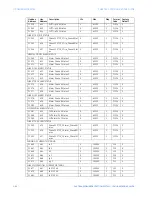
1–72
345 TRANSFORMER PROTECTION SYSTEM – COMMUNICATIONS GUIDE
USB INTERFACE
CHAPTER 1: COMMUNICATIONS GUIDE
USB interface
The USB inferface supports only the Modbus protocol.
For information on using the USB port on the 345 relay, please refer to Chapter 3 of the
345
Instruction Manual
.
MODBUS Protocol
The 345 implements a subset of the Modicon Modbus RTU serial communication standard.
The Modbus protocol is hardware-independent. That is, the physical layer can be any of a
variety of standard hardware configurations. This includes USB, RS485, fibre optics, etc.
Modbus is a single master / multiple slave type of protocol suitable for a multi-drop
configuration.
The 345 is always a Modbus slave. It can not be programmed as a Modbus master.
Computers or PLCs are commonly programmed as masters.
Both monitoring and control are possible using read and write register commands. Other
commands are supported to provide additional functions.
The Modbus protocol has the following characteristics.
•
Address: 1 to 254
•
Supported Modbus function codes: 3, 4, 5, 6, 7, 8, 10
Data Frame Format
and Data Rate
One data frame of an asynchronous transmission to or from a 345 typically consists of 1
start bit, 8 data bits, and 1 stop bit. This produces a 10 bit data frame. This is important for
transmission through modems at high bit rates.
Modbus protocol can be implemented at any standard communication speed. The 345
supports operation at 9600, 19200, 38400, 57600, and 115200 baud.
Data Packet Format
A complete request/response sequence consists of the following bytes (transmitted as
separate data frames):
Master Request Transmission:
SLAVE ADDRESS: 1 byte
FUNCTION CODE: 1 byte
DATA: variable number of bytes depending on FUNCTION CODE
CRC: 2 bytes
Slave Response Transmission:
SLAVE ADDRESS: 1 byte
FUNCTION CODE: 1 byte
DATA: variable number of bytes depending on FUNCTION CODE
CRC: 2 bytes
SLAVE ADDRESS
: This is the first byte of every transmission. This byte represents the user-
assigned address of the slave device that is to receive the message sent by the master.
Each slave device must be assigned a unique address and only the addressed slave will
respond to a transmission that starts with its address. In a master request transmission the
SLAVE ADDRESS represents the address of the slave to which the request is being sent. In a
slave response transmission the SLAVE ADDRESS represents the address of the slave that is
sending the response.
FUNCTION CODE
: This is the second byte of every transmission. Modbus defines function
codes of 1 to 127.








































